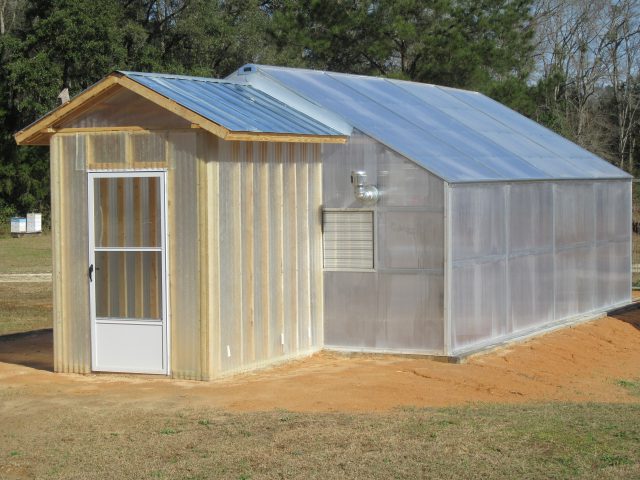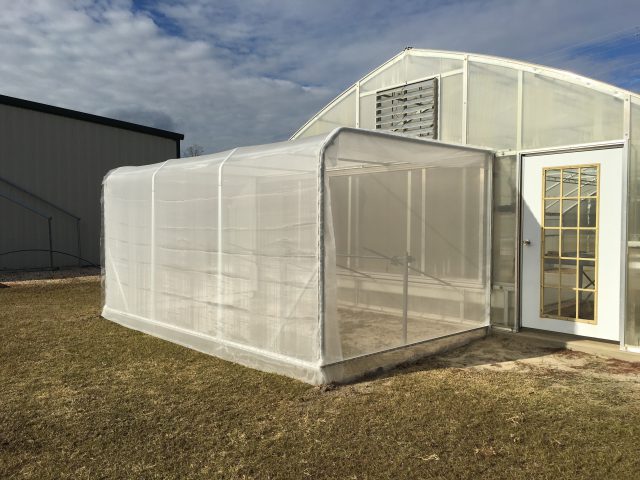Greenhouse vegetable production can help diversify your farm. Florida possesses a competitive advantage during winter months, because of much lower heating costs compared to other states and Canada. A major disadvantage, however, to producing greenhouse vegetables during the winter is the increased insect pest pressure at planting time (August – September). A key insect pest of vegetables during the fall is the silverleaf whitefly, which transmits a number of viruses and causes irregular ripening in tomatoes.
Because a number of greenhouse vegetables are grown through May, insect pest pressure remains high throughout the season, but please do not let these risks discourage you from venturing into greenhouse production. As you know, high risks often yield a big reward. Greenhouse vegetables are highly valuable during winter months. Exclusion of insect pests is the first step in implementing an integrated pest management (IPM) program in a greenhouse operation.
A well thought out IPM program includes the incorporation of cultural practices, biological controls, and reduced-risk insecticides. With the risk of potential problems associated with the use of chemicals in a greenhouse environment, growers should rely on exclusion as their first line of defense. Insect management should be a key consideration when designing a greenhouse. Insect screening is available for ventilation openings, but using this strategy may result in reduced airflow. Many screens that exclude insect pests can reduce airflow by 50% or more. The use of ultraviolet (UV)-absorbing plastics can reduce insect populations for plastic covered greenhouses. The UV-free light produced inside the greenhouse disrupts insect landing and feeding behavior, greatly reducing the spread of insect-vectored viruses.
Insect exclusion can be achieved through, but not limited to, four basic strategies: 1) Sanitation, 2) Air-lock entrance, 3) Insect Screening, and 4) UV Reflective Mulch.
Sanitation
The area around a greenhouse should be maintained relatively free of weeds and plant material that could harbor insect pests. This can be achieved with nursery cloth, or a ground cover in at least a 10 foot wide barrier around the structure. Preferably, a turf area should be maintained beyond this area. Other plant material in the general vicinity should be evaluated for their pest harboring ability.
An air-lock entrance on the front of a greenhouse. Photo Credit: Matt Lollar, University of Florida/IFAS Extension
Air-lock Entrance
Insect pests often enter through the front entrance of a greenhouse, because it is the path of least resistance. An air-lock entrance is critical in greenhouses with fan and pad type ventilation systems. An air-lock can be achieved through simply installing a room enclosing the entry doorway of the greenhouse. This extra room allows workers to close the outside door behind them reducing the chances of pests being pulled in by the ventilation suction. The air-lock entrance room can also be utilized to house a foot-bath, hand washing area, and any other sanitation stations.
An insect screen room on the outside of a greenhouse. Photo Credit: Atlas Manufacturing, Inc.
Insect Screening
Insect screening allows for adequate ventilation while still maintaining exclusion properties. Screens can be used in both passively ventilated and fan and pad greenhouses by either installing a screen box around the outside fan system or by simply installing material to roof vents. It is important to keep in mind that any size screen mesh will reduce the air flow in the greenhouse. Improper sizing has the potential to burn fan motors or reduce cooling. It is important to follow recommendations from the manufacturer in regards to screen size and surface area covered.
Reflective Mulch
Ultraviolet (UV) reflective mulch has been used in field grown production for quite some time. A similar approach can be utilized in greenhouse production to help deter and confuse pests from entering through the ventilation system. Research has shown it is important to install reflective mulch in at least a 20 foot wide, continuous barrier from the ventilation air intake end wall. Mulch along the sidewalls may also help repel insect pests. It is recommended that reflective mulch be used in conjunction with screening for an optimal effect.
Reflective mulch being installed near the cooling pad area of a greenhouse. Photo Credit: Marie Arick, University of Florida/IFAS Extension
Greenhouse insect pests cause significant damage to foliage, blossoms, and fruit, and also vector (transmit) diseases. It is important to develop an effective IPM strategy that involves exclusion as a first line of defense. Very few management options are available once insect pests have entered the greenhouse.
For more information, there is a series of short videos on these topics: UF/IFAS Greenhouse Pest Exclusion Videos
 0
0



